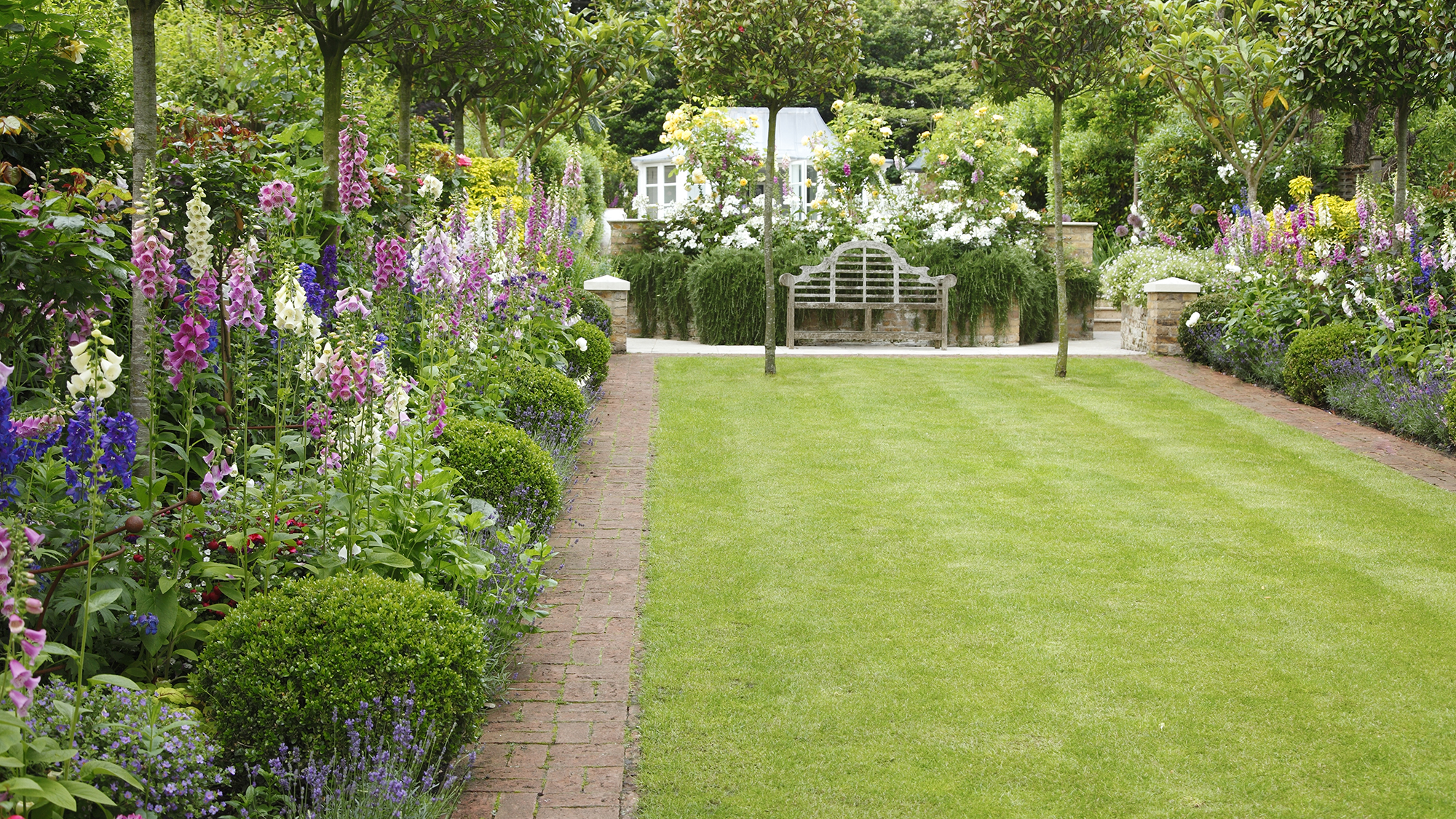Repairing patches in grass – an expert guide
Bare, yellow or brown patches in grass can ruin the look of a lawn. These are the best ways to repair them


If you have noticed patches in grass, you may be considering some lawn repair this weekend. Expert gardeners will know that it is possible to prevent and cure patchy grass quickly and fairly easily, however, before you begin, it is worth working out what might be causing them in the first place so that they don't return again quickly.
Some reasons for patches in grass will be easy to identify: wear and tear from the kids' lively football games and the dog are two obvious places to lay them blame, but bare or brown patches in lawns might be down to disease instead, which you will need to deal with differently.
So, if you’re looking to maintain your lush greenery – or you require some emergency lawn patch remedies – these expert tips are for you.
How to repair patches in grass

Before you start to working out whether now is a good time to plant grass seed, you need to work out why you have patches in your lawn.
Gardening expert Saul Walker explains: ‘Patchy grass is usually caused by a myriad of problems from diseases, such as Red Thread and Snow Mould, pest damage, like Leatherjackets and Chafer Bug Grubs.’
Bare patches in grass can appear when you dethatch a lawn, too.
Saul Walker goes on to explain, patches in grass can often be caused by constant use, 'poor drainage or a poor top.' The latter is particularly common in newly built properties. 'Identifying which problem you have and remedying it is always the first step in reviving your lawn before either repairing or replacing it,' he says.
Design expertise in your inbox – from inspiring decorating ideas and beautiful celebrity homes to practical gardening advice and shopping round-ups.
Also investigate when to add lime to lawns, as the pH of the soil could be causing the patches and poor health of the grass.
1. Penetrate grass roots with aeration
Saul, along with garden expert Noah James, recommends the process of aeration that will ‘increase airflow to the roots, encouraging oxygen for root health.’ Stronger roots grow deeper and promote a verdant lawn that is more resistant to future patching. The process also eases soil compaction for a versatile lawn for the cooler seasons ahead.
2. Sow grass seed
Perhaps the most impactful way to cure your patchy grass begins with a new fast-growing grass seed. Try to buy the same grass seed as you have used in the past as this will give you a consistent-looking lawn.
Before sowing, cut and lift out the bare or brown patch in a square and loosen the soil beneath. Replace the removed sod with top soil or compost, or a mixture of both, then scatter the seeds over the area, following the instructions for distribution on the seed packet.
Saul suggests that planting grass seed is 'best undertaken in the cooler, moister seasons of spring and fall to allow for the best establishment – after which regular scarification and aeration will keep your lawn in its best condition.’
Once you have done this, cover the seed with a little more top soil or compost (or both) so that you're not just providing birds with a lovely snack, and water carefully. If birds are a problem, you could peg a section of polythene over the seeded patch to protect the area and to stimulate germination.
3. Top-dress with nutrient-rich soil
One way to cure your grass patches and to keep your lawn green and thick is through the process of topdressing; as Noah recommends:
'Top-dressing with nutrient-rich soil can help make air, water, and nutrients available to the grassroots as it breaks down over time.'
The process encourages the grass to re-root and become thicker – and will not only restore your grass – but promote a healthier plot for the rest of summer.
4. Regulate your mowing
While it may seem entirely contradictory, the secret to patch-free grass is in a regular schedule with the lawn mower.
Founder of Garden’s Whisper, Stephen Webb suggests you should 'frequently mow at least once a week during the growing season, and three times a month in winter.' He adds that grass should be kept 'two inches above the ground'.
5. Patch with sod
Another quick tip that will heal your patchy grass? Founder at Evergreen Seeds, Emma Sophie, recommends laying sod at any point in the season in a way that is similar to how you would patch with seeds.
As with seeds, try to buy sod from the same supplier as you got it from first time around, or try to ensure you have the same type of grass to ensure an even finish.
You will need to cut out the patchy grass in a square or rectangular shape to match the shape and size of the section of sod, and loosen the soil beneath with a garden fork.
‘Keep the area an inch below so that it can be leveled up with the ground. Once this is done, cut a piece of sod and fix it on the repair site. Gently press the patch and walk on it, so it gets settled down. Then water the area properly so that it goes down in the soil,’ Emma explains.
Why are there brown patches in my lawn?
Brown patches in a lawn may be one of two things. Firstly, your grass may just be dormant in areas, which means it will come back. Or, it could be diseased or dead, and of course it's important to know the difference before you repair the lawn.
Dormant grass should still have healthy roots so won't come away if you grab a handful and gently pull it. However, bear in mind that dormant patches will be large, as grass doesn't become dormant in small, isolated areas. Why does grass become dormant and go brown? These tend to be cold-season grasses that don't like heat, or warm-season grasses that don't like the cold; once the temperature is more favorable, they will grow green again. To avoid this in future, combine warm- and cool-season grass seed when you sow.
Diseased patches may need diagnosis from a lawn repair professional, who can then deal with whatever is afflicting it.
Dead grass will come away in your hand if you grab a handful and gently pull it. With dead brown patches in grass, you will need to replace the sod or reseed the patch. With dormant patches.
Will brown patches in a lawn grow green again?
Provided the grass isn't diseased or dead, grass will grow green again when the temperatures are right for it, and if you water it regularly once the frosts have passed.
What causes bare patches in lawns?
Bare patches in lawns are generally caused by wear – and is easily fixed if you can persuade the kids to play elsewhere, rethink where you position your water slide or take a different route to the garden shed, or lay a path to replace the bare patches.
Bare patches can also be caused by excessive shade. You may be able to turn this around by pruning shrubs and trees, by sowing a shade-tolerant grass seed and by not cutting the grass too short. This area of lawn will also need feeding.
And, of course, patches may be caused by dog urine.
How to repair dog urine patches in a lawn
Dead grass patches in a lawn or yellow patches in a lawn are often caused by dog urine. It is not easy to stop your dog peeing, but there are actions you can take to minimize the damage.
Dilute the dog pee: this really only works if you are prepared to follow your dog out into the garden each and every time then turn a hose or watering can on to it immediately after the dog has done his/her business.
Put on the sprinkler in dry weather: your lawn will have a better chance of being patch-free if you can keep it damp, which means keeping it well-watered in dry spells.
Keep the lawn long: doing so will help retain moisture in the grass, which will lessen the likelihood of brown patches.
Feed the lawn: a healthy lawn is less likely to suffer from urine burn.

Lucy Searle has written about interiors, property and gardens since 1990, working her way around the interiors departments of women's magazines before switching to interiors-only titles in the mid-nineties. She was Associate Editor on Ideal Home, and Launch Editor of 4Homes magazine, before moving into digital in 2007, launching Channel 4's flagship website, Channel4.com/4homes. In 2018, Lucy took on the role of Global Editor in Chief for Realhomes.com, taking the site from a small magazine add-on to a global success. She was asked to repeat that success at Homes & Gardens, where she has also taken on the editorship of the magazine.